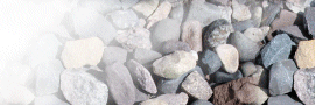|
|
|
|
|
Magnetic cohesion
|
When placed in a very strong magnetic field, magnetic dipole moments are induced in weakly magnetic particles. These dipole moments interact, resulting in magnetic cohesion between the particles. One parameter used as a measure of cohesion is the angle of repose of a granular pile. We have investigated the effect of magnetic cohesion on the angle of repose, using two-dimensional molecular dynamics simulations of granular piles (see Figure 1). Our simulations show that the angle of repose increases linearly with magnetic cohesion. Shear occurs deep in the pile, and the addition of a magnetic field causes the avalanche motion to shift farther down into the pile, preventing the slope angle from increasing substantially. We have investigated different models of wall friction, and discover that the wall interactions have a significant influence on the rate of increase of the slope angle with magnetic cohesion.
|

|
Figure 1: A granular pile in two-dimensional molecular dynamics simulations. In this picture, the inter-particle cohesive forces are five times stronger than gravity. The straight line is a fit to the surface particles (shaded).
|
|
|







